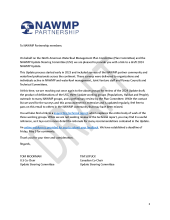
2024 North American Waterfowl Management Plan Update
Expanding the Partnership through Multiple Waterfowl Habitat Conservation Benefits
Executive Summary
The North American Waterfowl Management Plan (NAWMP) began as a response to declining waterfowl populations in Canada, the United States and Mexico in the mid-1980s and has subsequently served as the foundation for continental conservation of waterfowl and their habitat for nearly 4 decades. The NAWMP has been adaptive and extraordinarily successful in conserving waterfowl habitat and sustaining populations across the continent. However, the landscapes that sustain waterfowl are not static – they change, sometimes dramatically, and often in response to anthropogenic influences, including agricultural intensification, urban and industrial development, increased demands for water, and many other factors. Collectively, these factors degrade landscapes that support waterfowl, and they disrupt the ecosystem services that support people and their communities. Climate change also introduces great uncertainty and will exacerbate challenges encountered as NAWMP works to sustain habitat that supports waterfowl and other species of birds and wildlife.
Factors degrading the ability of landscapes to support waterfowl and provide other important ecosystem services are more prevalent than ever and present the greatest challenges and threats to waterfowl today. In most landscapes important to waterfowl across North America, the challenge remains to deliver habitat conservation at a rate and scale that halts or reverses ongoing habitat losses and ensures that waterfowl populations, which will always fluctuate, do so in a manner that does not result in a net decline in populations over the long term. The value of the NAWMP partnership and its continental efforts to conserve wetlands and waterfowl are as important today as ever.
Since the beginning, the NAWMP has implicitly acknowledged that people fundamentally value waterfowl, wetlands, and ecosystem services that wetlands and associated habitats provide. The NAWMP has never wavered in its focus on waterfowl and wetlands conservation, though it continues to be challenged to conserve habitat at a rate and scale that eliminates or offsets losses. A unique opportunity exists to conservation activities under the NAWMP via leveraging the ecosystem services resulting from its conservation work to engage broader audiences, and attract more and diverse partners, supporters and resources that arise from its habitat conservation accomplishments.
Some NAWMP partners already communicate the multiple benefits that accrue from waterfowl habitat conservation, and developed business or conservation strategies that include ecosystem services. This approach is being recognized by policy makers, funders, and other conservation interests. Some examples include large-scale wetland protection or restoration to reduce flooding, and nitrogen and phosphorous entering waterways in Iowa (Janke and Shannon 2023 https://nawmp.org/content/nawmp-webinar-series) and the Prairie Habitat Joint Venture region (Pattison-Williams et al. 2018); identification of wetland and floodplain restoration projects to reduce the impacts of floods and droughts on communities along the Mississippi River and provide critical migratory and wintering habitat on the Mississippi Flyway (Herbert 2023 https://nawmp.org/content/nawmp-webinar-series); strategically restoring wetlands to recharge groundwater to support both agriculture and increase drinking water supplies in the Playa Lakes Joint Venture region (https://pljv.org/playas/tomorrows-water/); working with ranchers to maintain or restore forage in flood-prone areas to benefit cattle production and waterfowl and other wildlife in the Rainwater Basin Joint Venture (Wetland Management - Rainwater Basin Joint Venture (rwbjv.org)); and provision of wastewater treatment technology to people sharing landscapes with waterfowl to improve water and habitat quality in wetlands (Ducks Unlimited de Mexico http://dumac.org/en/dimensiones-humanas/).
Waterfowl and their habitats will always be the core focus of the NAWMP. However, given the NAWMP’s formal recognition of the importance of people interested in wetlands conservation in 2012, unique opportunities exist to extend discussions with, and engage new supporters and partners. This dialogue will be supported by more effective evaluation of the multiple benefits of NAWMP’s conservation outcomes. Effective communication and focused outreach based upon demonstrated multiple benefits of NAWMP conservation efforts can and will bring additional partners and resources to enable the NAWMP to increase the scale and rate of work to meet the difficult challenges faced by and pressures on North America’s wetland and waterfowl habitat. The NAWMP is one of the best examples
of the delivery of nature-based solutions to address environmental challenges on a broad, landscape-level scale. The ability of the NAWMP Joint Ventures (hereafter Joint Ventures) to incorporate such opportunities into their business models can accelerate progress toward NAWMP objectives as well as important conservation objectives valued by people across North America.
The potential for new partners and supporters is significant and may include Indigenous Peoples, local or regional governmental agencies interested in reducing flooding or improving quality and quantity of their water supply to sustain their communities, or private landowners seeking sustainable approaches to manage working lands. Further, many corporations and foundations seek opportunities to support delivery of nature-based solutions to ecological issues faced by people and their communities across North America. Indeed, whether new partners join the NAWMP partnership , or the NAWMP reaches out and collaborates with other entities engaged in conservation efforts aimed at non-waterfowl objectives, but which are still beneficial to waterfowl habitats and populations, significant opportunities exist to increase the scale and accelerate the rate of NAWMP habitat conservation work to halt or reverse factors that degrade important waterfowl landscapes.
Simply stated, the future success of waterfowl conservation depends on the degree to which the NAWMP is successful in growing and diversifying its partnership base. Expanding the NAWMP umbrella, by listening to and to engaging new and diverse partners, is a timely and logical step to secure additional resources – to put more fuel in the tank – to achieve the NAWMP vision and goals for waterfowl populations and habitat, and people.
